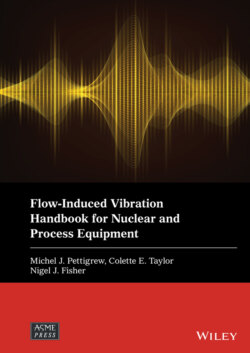Читать книгу Flow-Induced Vibration Handbook for Nuclear and Process Equipment - Группа авторов - Страница 52
2.6.1 Fretting‐Wear Assessment
ОглавлениеFretting‐wear damage may be estimated using the following modified Archard equation:
(2‐51)
where is the volume fretting‐wear rate, KFW is the fretting‐wear coefficient, and is the normal work‐rate. Work‐rate is the available mechanical energy from the dynamic interaction between tube and support and is an appropriate parameter to predict fretting‐wear damage. Work‐rate may be calculated by performing a non‐linear time domain simulation of a multi‐span heat exchanger tube vibrating within its supports (Yetisir and Fisher, 1996). Alternately, work‐rate may be estimated with the following simplified expression (Yetisir et al, 1998 and Pettigrew et al, 1999):
(2‐52)
where m is the total mass of the tube per unit length, and and f are, respectively, the maximum mean‐square vibration amplitude and natural frequency of the tube for the worst mode. The worst mode of a given region is defined as the mode of vibration that has the highest value for the normal work‐rate term, , in Eq. (2-52). The length, ℓ, is that of the span where the vibration amplitude is maximum and ζs is the damping ratio attributed to the supports.
Fig. 2-23 Vibration Mode Shapes and Vibration Analysis Results for a Typical Condenser Tube.
